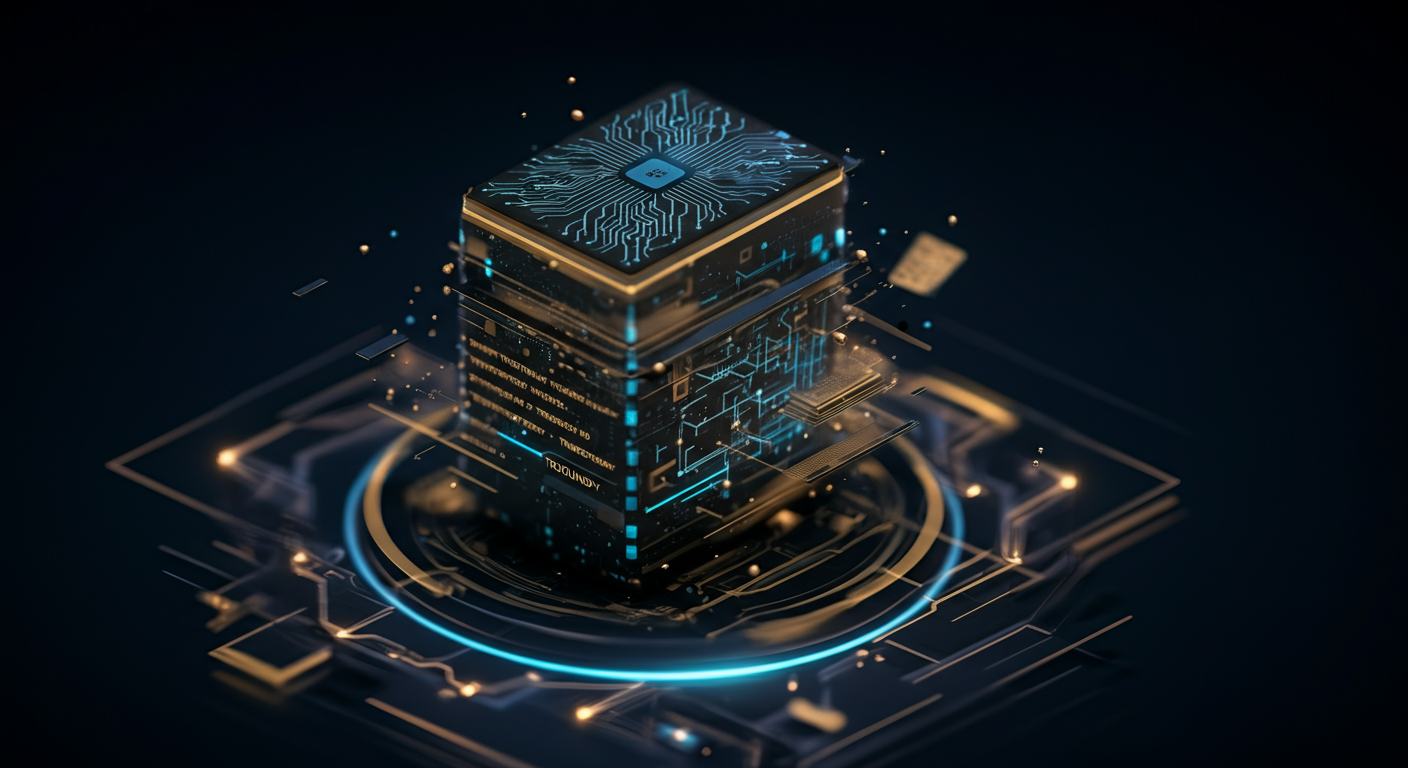Revolutionizing AI: Google's Breakthrough in Differentially Private Machine Learning

Here's the paradox of AI: to build trustworthy systems, we must first trust them with our data.
Demystifying Differential Privacy: The Foundation of Secure AI
Differential privacy (DP) is the tech world's answer to the question, "Can we use data to learn valuable insights without revealing sensitive information about individuals?". Think of it like this: imagine you're trying to guess someone's favorite ice cream flavor, but they only tell you the average flavor preference of a large group, with a little bit of "noise" added in to obscure the individual's real choice. That's DP in action! It's about adding calibrated noise to the data, ensuring the outputs of any analysis don't betray private facts. ChatGPT uses similar techniques to ensure that personal information is not exposed when training its models.
Dispelling Anonymization Myths
Don't be fooled: simple anonymization isn't a magic wand.
Think of the infamous Netflix Prize challenge, where "anonymized" movie ratings were easily de-anonymized by linking them with public IMDb data. DP, conversely, provides a mathematical guarantee that an individual's presence (or absence) in a dataset won't significantly impact the outcome of an analysis.Removing names, addresses, and even seemingly innocuous details can still leave individuals vulnerable to re-identification.
Navigating the Regulatory Maze
The world is wising up to data privacy. GDPR, CCPA, and similar regulations are setting a new standard. Here's where DP shines. It isn't just a nice-to-have; it's a strategic tool for compliance. By using techniques like DP, organizations can analyze data, create marketing automation strategies, and make data-driven decisions without running afoul of these regulations, and without sacrificing user privacy.
The Math(ish) Behind the Magic
While the equations underpinning DP can get a bit dense, the intuition is straightforward.
- Epsilon (ε): This is your privacy budget, defining the maximum amount of privacy loss that's acceptable for any single query. Lower epsilon = stronger privacy, but potentially reduced accuracy.
- Adding Noise: The core idea is to add random noise to the query result. The amount of noise is calibrated to the sensitivity of the query and the privacy budget.
Real-World Wins
DP isn't just theory; it's being used right now to protect privacy in impactful ways:
- Google: Employs DP in various products, including Chrome's crash reporting and location data analysis.
- Apple: Uses DP to discover usage patterns in iOS, like popular emojis, without revealing individual user data.
Ready to dive deeper? Check out this article on the best AI tool directory to discover the tools available.
Google's breakthrough in differentially private machine learning unlocks new possibilities for data analysis while fiercely protecting individual privacy.
Understanding Partition Selection
Partition selection is about strategically dividing data into smaller, more manageable subsets. This process is vital in machine learning and data analysis because it allows for more focused and efficient examination of complex datasets. Imagine trying to understand a city by analyzing the entire population at once; it’s much easier to break it down by neighborhoods! Differentially private partition selection ensures that these analyses don't reveal sensitive information about individuals. This research is particularly useful in scenarios where data is aggregated from various sources, such as healthcare records or financial transactions, where protecting user privacy is paramount.Google AI's Algorithmic Innovations
Google AI's research introduces innovative machine learning algorithms specifically designed for differentially private partition selection. These algorithms aim to achieve an optimal balance between privacy, accuracy, and computational efficiency. One approach involves adding carefully calibrated noise to the data selection process. Instead of directly choosing the best data partition, the algorithm introduces a randomized element, making it difficult for an adversary to infer specific details about individual records. Another method focuses on iteratively refining partitions while injecting noise at each step, thus ensuring privacy is preserved throughout the entire process.
Addressing the Trade-offs
These algorithms address previous limitations where strong privacy guarantees often came at the cost of significant accuracy loss or computational burden. Google AI’s methods improve upon these earlier approaches by using more sophisticated noise injection techniques and optimized computational strategies."Our goal is to provide robust privacy without sacrificing the utility of the insights derived from the data."
To ensure optimal usage, understand your data and privacy parameters before diving in with any Data Analytics tool.
In essence, this research represents a crucial step forward in making privacy-preserving data analysis more practical and powerful.
Google's differentially private machine learning algorithms may just be the key to balancing AI progress with individual privacy.
Technical Deep Dive: Inside the Algorithms

These algorithms aren't just clever tricks; they're built on solid math and innovative approaches to data handling, making it possible to train powerful AI models without exposing sensitive personal information. Let's crack open the hood and take a look.
Core Concept: Differential Privacy: At its heart, differential privacy adds carefully calibrated noise to the data or the model's learning process. This prevents attackers from inferring information about any specific* individual in the dataset. >Think of it like adding static to a broadcast – the overall message is clear, but individual whispers are lost.
Key Mathematical Tool: The algorithms often leverage concepts from information theory, probability, and statistical inference. For instance, the Laplace mechanism* is commonly used to add noise proportional to the sensitivity of the function being computed. The formula looks something like this:
Output = f(x) + Laplace(λ)
Where:
-
f(x)is the original function -
λis a parameter that controls the amount of noise added - Model Compatibility: These algorithms are designed to be versatile. They can be applied to a wide range of machine learning models, including:
- Decision Trees
- Neural Networks (with careful gradient clipping)
- Regression Models
- Parameter Sensitivity: The "privacy budget" (ε, delta) needs careful tuning. Smaller values offer more privacy, but can significantly impact model accuracy. Finding the right balance is crucial and often requires experimentation and validation.
- Limitations and Challenges:
- Accuracy Trade-off: There's always a trade-off between privacy and accuracy. More privacy generally means lower model performance.
- Complexity: Implementing these algorithms can be complex and requires a solid understanding of both machine learning and differential privacy concepts.
- Open Source Resources: Researchers are actively contributing to the field. Keep an eye out for open-source implementations on platforms like GitHub to stay at the cutting edge.
Revolutionizing AI privacy isn't just about Google; it's about setting a new standard for responsible innovation.
Beyond Google: The Broader Impact on AI and Machine Learning
Google's advancements in differentially private machine learning are significant, but the real excitement lies in the broader applications, which are really taking off thanks to AI directories like Best AI Tools. This directory makes it easy to search and discover the best tools to power up your AI innovation. These algorithms offer a blueprint for ensuring data privacy across numerous industries, potentially revolutionizing how we handle sensitive data in the age of AI.
Industries Ripe for Transformation
- Healthcare: Imagine AI-powered diagnostics trained on patient data without compromising individual privacy. Doctors and healthcare providers can find specific AI tools tailored for them at AI Tools for Healthcare Providers.
- Finance: Banks could use differentially private AI to detect fraud and manage risk while safeguarding customer financial information.
- Government: Policymakers could leverage these algorithms to analyze census data and inform policy decisions, without exposing individual citizens' details.
Ethical Considerations and Future Research
We must actively address the ethical considerations. While differential privacy adds a layer of security, it's crucial to continually refine and audit these systems to prevent unintended biases or misuse. For example, researchers in Scientific Research are starting to uncover complex biases across AI models. The future holds the exciting promise of even more sophisticated privacy-preserving techniques and exploring federated learning, which allows models to be trained on decentralized data sources.
Forget sensitive data breaches – the future of AI is privacy-preserving.
Practical Implementation: A Step-by-Step Guide (Conceptual)

Implementing differentially private machine learning isn't about flipping a switch; it's a thoughtful process. This guide outlines the steps conceptually. Actual implementation may demand specialized expertise.
- Data Assessment and Preparation: Understand your data's sensitivity. Identify which attributes need protection and the level of privacy required.
- Algorithm Selection: Choose suitable machine learning algorithms amendable to differential privacy. Some algorithms integrate more seamlessly than others.
- Consider libraries like TensorFlow Privacy or PyTorch Differential Privacy.
- These tools provide mechanisms for injecting noise and clipping gradients.
- Privacy Budget (ε and δ): Define your privacy budget. This involves setting values for epsilon (ε) and delta (δ).
- Epsilon controls the privacy loss from querying the dataset. A smaller epsilon implies stronger privacy.
- Delta represents the probability of a total privacy breach. It should be kept very small.
- Noise Addition: Implement mechanisms to add controlled noise to the data or the learning process. Algorithms like the Laplace mechanism and Gaussian mechanism are standard.
- Parameter Tuning: Adjust model parameters and noise levels to balance privacy and accuracy. It's an iterative process!
- Validation and Testing: Rigorously test the differentially private model for both privacy guarantees and performance metrics. Tools for Data Analytics can be useful here.
- Deployment and Monitoring: Deploy the model but continuously monitor its privacy guarantees and performance.
In conclusion, implementing differentially private machine learning is a challenging, iterative process that balances privacy and utility. Keep innovating!
Here's to a future where AI respects, not reveals, our secrets.
The Future of Privacy-Preserving AI: Trends and Predictions
The surge in AI adoption brings with it a critical imperative: protecting user data. Fortunately, the brilliant minds are already cooking up innovative solutions. Let’s peer into the crystal ball and see what the future holds.
Emerging Privacy-Preserving Techniques
- Federated Learning: Imagine training a model across millions of devices without ever centralizing the data. That's the beauty of federated learning.
- Homomorphic Encryption: This is straight out of a science fiction novel! Homomorphic encryption allows computations to be performed on encrypted data without decrypting it first. This enables AI models to analyze sensitive data without ever seeing it in the clear.
- Differential Privacy: This is a system for publicly sharing information about a dataset by describing the patterns of groups within the dataset while withholding information about individuals in the dataset.
Predictions and Societal Impact
I predict that research in differential privacy will explode, leading to more sophisticated and robust techniques. Imagine AI algorithms embedded in healthcare, finance, and law, processing sensitive information with ironclad guarantees of privacy. The impact on society and the economy would be seismic, fostering trust and unlocking new avenues for innovation.
Recommendations for Organizations
Organizations looking to adopt privacy-preserving AI should consider the following:- Invest in Research: Dedicate resources to exploring and implementing these advanced techniques.
- Prioritize Transparency: Be open about your data handling practices to build trust with users.
- Explore prompt engineering: With careful prompt library strategies, many privacy implications can be reduced.
The Regulatory Maze
The regulatory landscape surrounding AI and data privacy is evolving rapidly. GDPR, CCPA, and other regulations are forcing organizations to rethink their approach to data handling. Staying ahead of the curve is crucial. Organizations that proactively embrace privacy-preserving AI will not only comply with regulations but also gain a competitive edge by building trust with their customers. And compliance is good business.
Keywords
Differential Privacy, Machine Learning Algorithms, Google AI, Partition Selection, Privacy-Preserving Machine Learning, Data Privacy, Algorithmic Privacy, AI Security, Federated Learning, Privacy Engineering
Hashtags
#PrivacyAI #DifferentialPrivacy #MachineLearning #AISecurity #GoogleAI
Recommended AI tools
ChatGPT
Conversational AI
AI research, productivity, and conversation—smarter thinking, deeper insights.
Sora
Video Generation
Create stunning, realistic videos and audio from text, images, or video—remix and collaborate with Sora, OpenAI’s advanced generative video app.
Google Gemini
Conversational AI
Your everyday Google AI assistant for creativity, research, and productivity
Perplexity
Search & Discovery
Clear answers from reliable sources, powered by AI.
DeepSeek
Conversational AI
Efficient open-weight AI models for advanced reasoning and research
Freepik AI Image Generator
Image Generation
Generate on-brand AI images from text, sketches, or photos—fast, realistic, and ready for commercial use.
About the Author

Written by
Dr. William Bobos
Dr. William Bobos (known as 'Dr. Bob') is a long-time AI expert focused on practical evaluations of AI tools and frameworks. He frequently tests new releases, reads academic papers, and tracks industry news to translate breakthroughs into real-world use. At Best AI Tools, he curates clear, actionable insights for builders, researchers, and decision-makers.
More from Dr.

